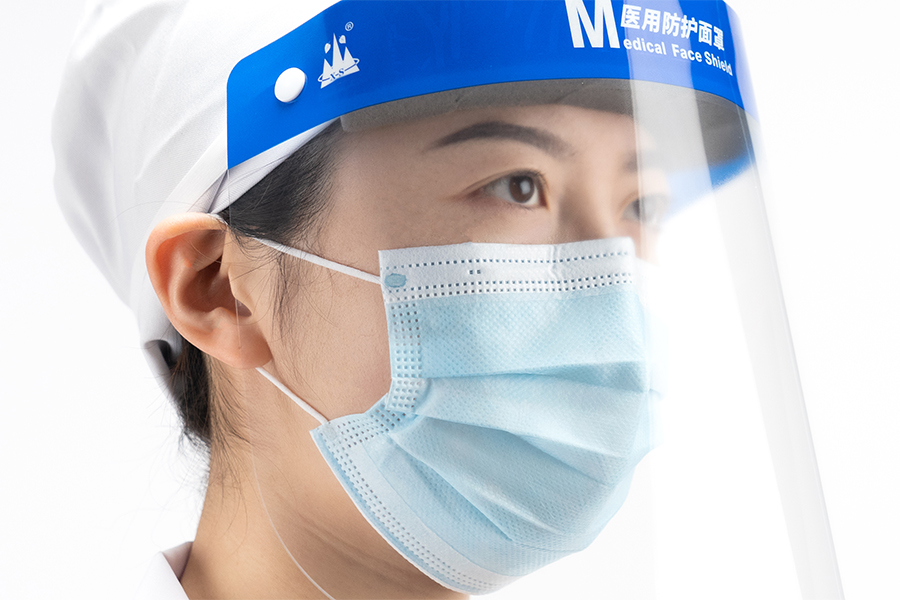The size and shape of a medical face shield have a significant impact on both its level of protection and comfort for the wearer. Here’s how these two factors influence the effectiveness and comfort of the shield:
Protection
Coverage Area:
A face shield that covers the entire face, including the forehead, eyes, nose, mouth, and chin, provides comprehensive protection from respiratory droplets, splashes, and aerosols. This full coverage helps to prevent contamination from a variety of directions (front, sides, and top) and reduces the risk of direct exposure to infectious agents, such as viruses and bacteria.
Wider shields that extend beyond the sides of the face provide more lateral protection, which is particularly important in environments where the wearer may be exposed to splashes or droplets from different angles.
Shield Length:
A longer shield that extends below the chin can help prevent droplets from entering the gap between the shield and the wearer's neck. It reduces the risk of exposure from fluids that may fall downward during certain medical procedures or when patients are coughing or sneezing.
However, a shield that’s too long might become cumbersome or hinder movement, which can affect the wearer’s ability to work efficiently, especially in tight spaces.
Shape of the Shield:
The curve or shape of the shield is important for its ability to deflect droplets and aerosols. A shield with a slightly convex shape (curved outward) can help divert droplets and prevent them from bouncing back toward the face. The curvature should also allow for airflow around the face, reducing discomfort from heat buildup and fogging.
A flat shield may not offer the same level of protection against droplets from all angles, as it may not effectively redirect them away from the face.
Comfort
Fit and Adaptability:
The size of the face shield needs to be suitable for the wearer’s head to ensure a secure fit. A shield that is too large may be prone to shifting or falling off, while one that’s too small may not offer adequate coverage and could press uncomfortably against the face. Adjustable straps, headbands, or elastic bands help improve comfort and ensure a snug, secure fit.
Some face shields come with a foam padding on the forehead or the top of the shield, which provides cushioning and reduces pressure on the skin. This is important for extended wear, as it minimizes irritation and discomfort.
Weight and Balance:
A heavier shield may cause strain on the wearer’s neck and shoulders, especially if worn for long periods. This can lead to fatigue and discomfort. Lighter shields are generally preferred for extended use because they are less taxing on the body, but they still need to maintain sufficient protection.
The balance of the shield is also important. A well-balanced shield that sits comfortably on the head without tilting too much forward or backward can reduce neck strain and improve comfort during prolonged wear.
Visibility and Field of View:
The size and shape of the shield should not obstruct the wearer’s field of vision. Shields with an excessive width or height may limit peripheral vision, which could affect the wearer’s ability to move or interact safely in certain medical settings.
Clear, wide shields improve visibility, allowing the wearer to maintain awareness of their surroundings while still offering protection. Face shields that extend to the sides without obstructing the wearer’s view are ideal for ensuring both protection and comfort.

Design Features
Anti-fog Coating:
A well-designed face shield with anti-fog treatment or a vented top can help minimize the buildup of condensation, which is often a problem when wearing the shield for long periods. Fogging can obstruct vision, making it difficult to see patients or perform tasks accurately. The shape of the shield, including a slight curve at the top, can help promote airflow to reduce fogging.
Adjustable Fit for Comfort:
Adjustable straps and headbands, along with a properly sized shield, contribute to comfort. The wearer can customize the fit to avoid discomfort or pressure points on the head, which is especially important for long shifts in medical settings.
Elastic bands are often used to provide a more flexible and comfortable fit, accommodating different head sizes and ensuring the shield stays in place.
Impact of Shield Size on Practical Use
Movement and Flexibility:
A smaller shield or one with a more compact design may be preferable in situations requiring greater mobility or access to tight spaces. This is especially relevant for certain surgical procedures or when performing tasks that demand precision and close contact with patients.
A larger shield may provide more protection but could impede the wearer’s ability to move freely or engage in detailed work.
Considerations for Different Healthcare Settings
Surgical vs. General Use:
In surgical settings, where there’s an increased risk of exposure to bodily fluids and high-pressure sprays, a larger shield may be necessary to ensure comprehensive protection. The shape may also need to be more robust, with additional layers or coatings to withstand splashes.
For general healthcare use, such as during patient examinations or in administrative settings, a smaller, lighter shield that is comfortable for long periods may be more appropriate.

 English
English 中文简体
中文简体








